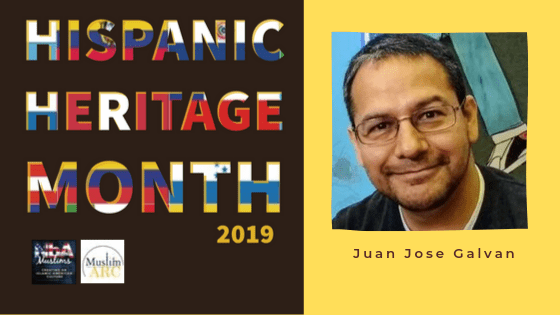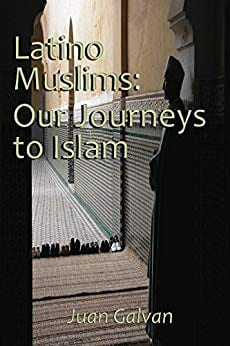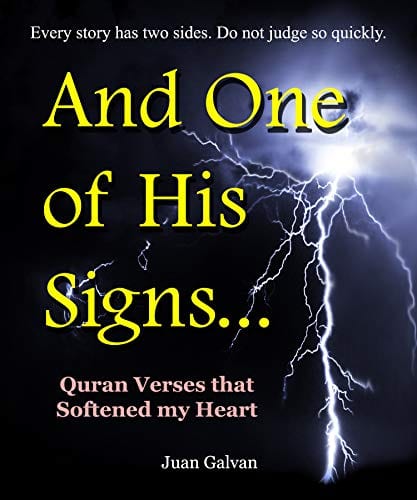SEPTEMBER 27, 2019 BY NBAMUSLIMS
https://www.patheos.com/blogs/nbamuslims/2019/09/27/hispanic-muslims-juan-galvan/

In honor of Hispanic Heritage Month, NbA Muslims, in collaboration with the Muslim Anti-Racism Collaborative, will feature Latinx Muslims engaged in progressive work inside and outside of US Muslim communities. This week, we profile Juan Jose Galvan, who has highlighted Latinx Muslims and advocated for appreciation for and inclusion of their unique cultural experiences in Muslim spaces and narratives.

Galvan is the editor of Latino Muslims: Our Journeys to Islam and served as the executive director of the Latino American Dawah Organization (LADO) from 2005 to 2013. He was the editor of its online newsletter, The Latino Muslim Voice, from 2002 to 2012. Through his role as the editor, he actively contributed articles to the newsletter, including Jesus and the Virgin Mary in Islam and FAQs about Latino Muslims. In his career, he has actively written about various Latino Muslim events, organizations and leaders. Juan manages the LatinoDawah.org and HispanicMuslims.com websites. He has a Bachelor of Business Administration in Management Information Systems (BBA-MIS) from The University of Texas at Austin.
Galvan advocates for the inclusion of the Latino Muslim voice in the mainstream Muslim narrative. He pushes for increased visibility of America’s Latino Muslims in religious publications. Juan has assisted dozens of students, professors, and reporters with research and has provided access to the Latino Muslim community through interviews and his writings. He has spoken at various Islamic conferences and developed a growing national reputation as a content expert on the Latino Muslim community through newspaper interviews and publications.
Galavan authored Latino Muslims: Our Journeys to Islam and the recently-released “And One of His Signs…”: Quran Verses that Softened my Heart.
When did Latino Muslim conversion begin to grow in the U.S.?

Following the tragedy of 9-11, many people came to learn about Islam for the first time. People wanted to know, “Is this Islam? What is Islam?” Many wanted to know why the attacks happened. So, millions of non-Muslims went out and purchased books about Islam, visited mosques, and heard lectures on Islam. Most Americans came to separate Islam and the greater Muslim community from those responsible for the 9-11 tragedy.
Some people came to hate Islam, and some people came to love Islam. Many people at least began to respect Islam. Largely, these adopted views depended on the information they read, heard, or watched about Islam. Many people studied Islam and liked what they read and then converted. I met a lady that said that she first started reading about Islam because she wanted to confirm that Islam was evil. After reading a lot about Islam, she converted to Islam! Many people returned to their churches, synagogues, and mosques while others came to churches, mosques, and synagogues for the first time. And, of course, we should not forget all the people and organizations that reached out to their neighbors for the first time.
Latino Muslims have been converting to Islam since before 9-11. The Latino Muslim community has consistently grown annually. I do not know how many Latinos embraced Islam after 9-11. Some Muslim organizations have stated that the Latino Muslim community tripled or quadrupled after 9-11. Like many other Americans, many Latinos embraced Islam after learning what Islam was really about.
In 2017, Dr. Gastón Espinosa, Dr. Harold Morales, and I released the results of the Latino Muslims Survey (LMS) in the Journal of Race, Ethnicity, and Religion. According to the report, the growth of conversion rates among Latinos in the U.S. is a relatively recent phenomenon though individual Latinos have been embracing Islam since the 1920s. Over 74 percent of LMS respondents reported having embraced Islam in the past fifteen years (1999-2014). Only 4 percent of Latino Muslims surveyed reported they were raised as Muslims.
What are some parts of the country with the highest number of conversions?
The size of the Latino Muslim population within a particular area typically corresponds to the size of the overall Muslim population within that area. For example, an area, whether city or state, with numerous Muslims, usually has more Latino Muslims than an area with fewer Muslims. You can find Latino Muslims in all major cities within the United States. The largest numbers of Latino Muslims live in cities with large numbers of both Latinos and Muslims, resulting from interactions between members from both communities. Cities with the greatest numbers of Latino Muslims include Los Angeles, Houston, New York City, and Chicago.
The number of Latino Muslims is difficult to determine because the U.S. Census Bureau does not collect information about religion. Estimates range from as low as 40,000 up to as high as 250,000. No precise numbers exist regarding the size of Latino Muslim populations in any specific cities or states. In Texas and California, most Latino Muslims are Mexicans or Central Americans. On the east coast. Latino Muslims are usually Puerto Rican or Dominican, which is not surprising considering the dispersion of the Latino population within the United States.
According to the LMS study, the states with the highest concentrations of Latino Muslim participants were California (19%), Texas (15%), New York (12%), New Jersey (11%), Florida (7%), Illinois (5%), Georgia (4%), and Pennsylvania (3%). The LMS survey found that most Latino Muslims are women (73%), were born in the U.S. (62%), and come from diverse countries of origin, even though a majority trace their ancestry to Mexico (31%) or Puerto Rico (22%).
What are some the common reasons Latino Muslims convert to the faith?
Why people choose Islam depends on the individual you ask. Many Latinos will just say that it is through Allah’s mercy and guidance. In our LMS report, we include the following table that shows the results of some questions we asked survey respondents. The Islamic belief in monotheism/Tawhid (95%) is a “very or somewhat influential” factors in Latino Muslims’ decision to embrace Islam. Other highly influential factors included the practice of daily prayers (76%), the Islamic belief in prophethood (75%), the racial/ethnic equality called for in Islam (74%), and the practice of charity/zakat in Islam (71%).
In the LMS report, we concluded that the high conversion rates of Latinos to Islam are largely due to a heavy emphasis on proselytism (dawah). We supported this finding by the fact that 40 percent first heard about Islam from a friend, 13 percent from a spouse or future spouse, and 8 percent from a family member, while only 4 percent first heard about Islam from a radio or television show, and 3 percent from an Islamic website. Roughly a third (33%) of the LMS respondents reported trying to convert others to Islam regularly; 11 percent did so every day; 10 percent once a week or more, and another 12 percent once a month or more. This focus on personal dawah helps explain the Latino Muslim growth between 1999-2014.
Because of a commonly held misconception that Islam was “spread by the sword,” many non-Muslims find it hard to accept that Latinos convert to Islam primarily because they fall in love with the teachings of Islam. Belief in Islam is a matter of the heart and mind. People also continue to associate Islam with polytheism or paganism when in reality it is the purest monotheistic religion. When you read the news, people seem to convert to Islam for every reason but belief. Many new Muslims often point out reasons that may have initially attracted them to Islam, and rather than putting these reasons into their proper perspective as part of the journey, they attribute them as the catalysts for conversion. Media coverage often overlooks the Islamic message of hope, love, and forgiveness. Unfortunately, Islam is seen as a foreign religion from a faraway land, and its followers are also seen as foreign and therefore, strange, different, and distant. Islam has many similarities with the other Abrahamic faiths that attract many non-Muslims. However, if Islam were exactly like other religions, non-Muslims would have no reason to embrace Islam. People are attracted to Islam because it is different. That is where the beauty comes from. I hope my book Latino Muslims: Our Journeys to Islam fights against this anti-Islam mentality. In my book, Latino Muslims from all walks of life discuss their conversion to Islam.
Are Latino Muslims integrating their cultural identities into their new faith experiences? How?

I strongly believe that the central role of the family is the most important aspect of Latino identity. The problems found in Latino families may be similar or maybe even the same as those in other communities. Different families have different problems. For example, a Latino immigrant to the United States may have a large, supportive family in her native country, knowing all their cousins, aunts, and uncles. These people are very important to them. If something happens, the family is there to help. However, this may change when moving to the US. They may question common values held in their home countries’ cultural identities and find themselves with little family support if any. Their family members experience a lot of stress and hardship. Problems they never imagined may occur. Families in Latino culture is very similar to how it is in Islam. Many Latinos are looking for a way to protect their family life and see Islam as a way of returning their family to its proper place in society. Islam takes what is beautiful and makes it more beautiful.
Most Muslim converts effortlessly adjust to their relationship with their family embracing their Muslim identity. No one wants to be the outcast. One of the worse things new Muslims can do is to alienate themselves from their family. Converting to Islam does not mean cutting ties. After becoming a Muslim, you are still a member of your family. Your mother is still your mother, and your father is still your father. Love towards your family is natural and unconditional. You should be kind toward your family. You should obey your parents and elders as long as their advice does not contradict the teachings of Islam. Embracing Islam is an opportunity to teach your family and friends about Islam. Know that they have a right to reject Islam if that is what they want. Also, know that you cannot take part in haraam, or prohibited, activities. Integration is not about rejecting everything about your culture. I still love the food I grew up eating but eat nothing that contains pork. These are important considerations for all Muslim converts integrating their cultural identities into our new faith.
What are some unique challenges facing Latino Muslims inside Muslim communities in the U.S.?
I appreciate the love and support we receive from other Muslims. Many mosques, Muslim organizations, and individual Muslims actively work with Latino Muslims on projects hoping to strengthen the Muslim community. CAIR, ISNA, MAS, and ICNA have programs geared specifically for Latino Muslims. ICNA/WhyIslam is a noteworthy example. Because Islam is a universal brotherhood, I deal with every Muslim as an individual and avoid stereotypes that can endanger our relationship with one another. Some raised Muslims have negative stereotypes about Latinos. Some people raised as Muslims think all Latinos are promiscuous and incapable of becoming a ‘real’ Muslim. Often, the different Muslim communities in the U.S. aren’t too sure how to relate to one another.
We all share our religion but we don’t all share the same connected histories. Latino Muslim history differs greatly from African-American Muslim history, for example. The Muslim communities are not all the same. Although you may feel welcomed at your mosque, it doesn’t mean a Latino will feel welcomed there. According to the LMS findings, three-fourths (77%) of those surveyed reported that Latino Muslims face racially or ethnically discriminatory attitudes (48%) or sometimes face racially or ethnically discriminatory attitudes by Muslims who are not Latino (29%). Only 15 percent reported that they do not face or sometimes face discriminatory attitudes by non-Latino Muslims.
Latino Muslims want to feel accepted and treated as equals. One reason Alianza Islamica was founded in the 1980s was that Latinos were constantly asked not to speak Spanish at the mosques they attended. The Bani Saqr, a mostly Puerto Rican Muslim community, was founded in New Jersey in the 1970s under the leadership of a well-respected African-American imam. I also encourage you to learn about the history of the Punjabi Mexican-Americans in California. The Latino Muslim community has been a bridge between Muslim communities because we can relate to both the native-born and immigrant Muslim communities through our common experiences. “O mankind, indeed We have created you from male and female and made you peoples and tribes that you may know one another. Indeed, the most noble of you in the sight of Allah is the most righteous of you. Indeed, Allah is Knowing and Acquainted.” – Quran 49:13.
What are some challenges facing Latino Muslims in Hispanic communities and the broader society?
Eighty-four percent (84%) of LMS participants reported that Latinos Muslims face discriminatory attitudes (63%) or sometimes face discriminatory attitudes (21%) by Latinos who are not Muslim. Many Latino non-Muslims genuinely believe that Islam is bad for the Latino community. They may be concerned with other Latinos leaving their “original culture.” But what is original culture? Latinos can’t define culture by religion because our ancestors were from all different religions. Many Hispanics think leaving Catholicism means rejecting their identity. We should reevaluate how we traditionally define culture. Although some people define culture as something static, I think defining culture as a dynamic process is more accurate. The current Latino culture is merely today’s Latino culture. If in a hundred years from now most Latinos are Muslim, the typical Latino would consider Islam inseparable from the Latino culture. Islam sets the framework and direction that the Latino Muslim culture takes. Accepting Islam means rejecting some old ways, accepting some new ways, and adapting when necessary. I am a Latino American and a Muslim. There is no contradiction in my identity.
Hispanic Heritage Month occurs annually from September 15th to October 15th. It celebrates the history, presence, and contributions of all Hispanics and Latinos in the United States and highlights the diversity of the Latino community. In the U.S., citizens have opportunities to interact with people from all nationalities, cultures, and religions. We live in the most diverse country in the world. Many people are not very supportive of diversity when it comes to Latino Muslims though. Many Americans do not appreciate all the cultural and religious diversity found in the United States. However, negative stereotypes are constantly challenged in our diverse society. Americans have been blessed to share their different beliefs, experiences, and perspectives. Latino Muslims are a great American story.
Note: According to a short survey I conducted last year, most Latino Muslims do not like being referred to as Latinx. Please forgive me if I have offended anyone.